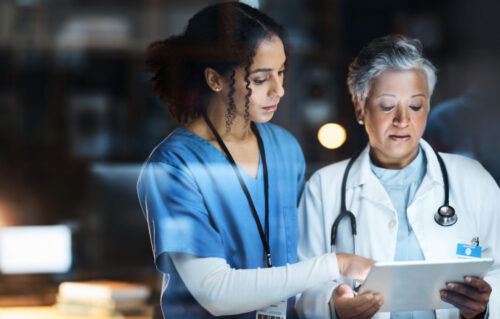
Talk with a ChartSpan Representative Today!
Our team is ready to help you improve patient care and outcomes.
Blog
How to Manage Chronic Hypertension with Chronic Care Management
As of 2023, almost half (48.1%) of American adults over 18 have high blood pressure. Out of these 119.9 million patients with hypertension, only 27% of them had their blood pressure under control through lifestyle alterations and medications. Uncontrolled hypertension puts tens of millions of people at risk of heart disease and stroke, the leading causes of death in the U.S.
Hypertension is most prevalent among older adults and Medicare beneficiaries. 70% of American adults over the age of 65 are diagnosed with high blood pressure. Hypertension often presents no warning signs, leading to the chronic disease being nicknamed the “silent killer.” It’s approximated that 1 in 5 hypertensive patients do not know that they have high blood pressure.
Hypertension also places enormous financial strain on the American healthcare system and patients. Every year, high blood pressure costs the U.S. over $131 billion. Patients with uncontrolled hypertension face staggering rates of hospital readmission, healthcare resource utilization, and higher risks of preventable death.
Fortunately, there are solutions to help engage patients on their healthcare journey and navigate their hypertension. Chronic Care Management (CCM) focuses on helping Medicare patients manage chronic conditions through preventative care, patient activation, and a consistent monthly communication cadence. CCM services are available to primary care providers and specialists that serve Medicare beneficiaries, allowing practices to monitor patient care plan progress continuously between clinical visits. See how a CCM program could benefit your practice and patients managing hypertension.
An overview of chronic hypertension
Chronic hypertension is elevated blood pressure that persists for longer than three months. The National Heart, Lung, and Blood Institute (NHLBI) divides chronic hypertension into two categories.
- Stage 1 hypertension is diagnosed when a patient consistently presents a systolic pressure measurement between 140–159 mm Hg and a diastolic pressure measurement of 9–99 mm Hg.
- Stage 2 hypertension is diagnosed when a patient consistently presents a systolic pressure measurement of 160 mm Hg or higher and a diastolic pressure measurement of 100 mm Hg.
High blood pressure causes elevated arterial resistance against blood flow. This increased force places enormous strain on the heart, brain, circulatory system, and all bodily organs. Hypertension is a direct cause of coronary heart disease, stroke, and numerous other life-threatening health complications.
What causes chronic hypertension?
Hypertension is frequently caused by aging, a sedentary lifestyle without physical activity or exercise, and obesity. Other common risk factors include elevated sodium intake, smoking, and alcohol misuse. High blood pressure can also manifest as a side effect of other chronic diseases or as a complication from certain medications.
How does Chronic Care Management help manage chronic illnesses?
Chronic Care Management (CCM) is a value-based Medicare program that provides care coordination and healthcare resources for patients managing multiple chronic conditions. CCM is a comprehensive care management service designed to minimize complications, promote improved quality of life, and actively engage patients in their healthcare journey.
CCM offers enrolled patients a wide variety of benefits and preventative services. CCM care managers create monthly communication touchpoints with patients to discuss their care plans, illnesses, and care coordination. These calls include aiding patients in arranging transportation to appointments, refilling medications, accessing health records, closing gaps in their care, and checking in on the progression of their symptoms. Patients also have 24/7/365 access to a nurse hotline, granting them around-the-clock access to professional medical guidance.
With continual provider feedback, CCM offers patients ongoing support and education about their illnesses, self-management tips, and lifestyle alteration recommendations. Data collected by the Centers for Medicare and Medicaid Services (CMS) demonstrates that patients enrolled in CCM often have fewer hospitalizations, emergency room visits, and lower readmission rates.
Learn more: How to Manage Common Chronic Diseases with Chronic Care Management
How to manage hypertension with Chronic Care Management
Chronic Care Management programs provide invaluable guidance, resources, and accountability to patients managing chronic hypertension. After diagnosis, patients will receive a hypertensive care plan from their physician. This care plan is designed to slow the progression of their illness, minimize adverse side effects, and promote a positive, healthy lifestyle. Hypertensive patients are usually required to make dramatic changes to their diet, lifestyle, and routine to minimize complications or exacerbation of their blood pressure.
These modifications can be challenging, and patients can easily become disheartened by the adjustments needed to preserve their health and promote an optimal quality of life. Older patients are especially vulnerable, as many lack a network of social support, suffer from isolation and loneliness, and are often already battling multiple debilitating chronic health conditions that may complicate physical exercise.
Most healthcare providers do not have the time or resources to check in with their hypertensive patients’ care plan progress every month. If a patient continues to eat a high-sodium diet and skips taking their prescribed heart medications, their blood pressure will continue to escalate. This patient may suffer a coronary episode with catastrophic consequences before their next appointment, incurring high financial expenses and further complicating their road to recovery and optimal wellness.
However, through a consistent, monthly communication cadence, CCM care managers offer these patients timely interventions, personalized assistance and recommendations, and meaningful human contact and encouragement. CCM programs reduce the risks of disengagement and health complications by routinely monitoring hypertensive patients’ symptoms and addressing questions and concerns about treatment and medications.
Overall, CCM helps activate hypertensive patients in their care journey by keeping them adherent to their physician-directed care plan and helping them overcome the obstacles they may encounter as they adjust their behaviors and eating habits.
Learn more: A Provider’s Guide to Chronic Care Management
Deliver exceptional care for your hypertension patients with ChartSpan’s CCM program
ChartSpan is an industry-leading provider of full-service, proactive CCM services. With clients ranging from rural health clinics to specialty providers like cardiologists, our expertise encompasses a diverse portfolio of healthcare practices and facilities.
Our care managers have a wealth of experience in assisting hypertensive patients with navigating their care plans, in delivering a patient-centered experience, and in improving patients’ quality of life. With the provider’s oversight , our team can offer hypertensive patients practical, everyday self-management tips, devise exercise plans, and share recipes and dietary advice.
As a provider, you may not have the bandwidth or resources needed to contact your patients every month. ChartSpan’s CCM program removes this burden from the practice and creates meaningful opportunities for accountability and engagement with hypertensive patients.
What are the benefits of CCM for patients with hypertension?
ChartSpan’s CCM offers numerous advantages, specifically for hypertensive patients. Hypertension benefits enormously from day-to-day adjustments, timely interventions, and consistent communication. The high level of personalization and accountability provided by high-quality CCM facilitates increased patient activation, satisfaction, and long-term retention.
1. Gain monthly insight into patient progress for primary care practices and specialists
Patients benefit when their healthcare providers possess accurate, up-to-date information on their health status and illness progression. Many healthcare providers can only gather patient data a few times a year. For patients with hypertension, it is critical to monitor blood pressure regularly to ensure that the modifications to diet and lifestyle are having the desired effect.
Through monthly calls, CCM care managers can gain insight into the day-to-day, patient-recorded blood pressure readings and assess care goal progress. These numbers are then reported back to providers. If a patient struggles to manage their blood pressure, this consistent line of communication allows for early interventions and proactive solutions.
This information is vital not only to primary care providers but also to specialists, like cardiologists. Patients with hypertension must control their blood pressure to maintain robust heart health and avoid cardiac complications. CCM programs like ChartSpan’s document these crucial insights into the patient’s care plan progress throughout the year for cardiologists. This saves these specialty practices time and energy and helps promote optimal health among their patient populations.
2. Provide patients with ongoing education and resources about blood pressure management
Patients may initially feel overwhelmed or confused by their hypertension diagnosis. Providers have limited clinical time to answer questions. CCM care managers, however, have monthly calls dedicated to answering patients’ questions about their illnesses, medications, and lifestyle alterations.
Care managers can provide educational materials to patients, help them understand the foods and behaviors that cause spikes in their blood pressure, and relay practical tips to help patients manage their disease. For example, a ChartSpan care manager may recommend a patient take their salt shaker off the table and place it on a high shelf in their cupboard to help break the routine of adding excess salt to a dish.
3. Assist patients with dietary changes
Adherence to a low-sodium, nutrient-rich diet is critical for managing hypertension. The CDC reports that over 86% of Americans with hypertension exceed the recommended daily dietary guidelines for sodium intake. Hypertensive patients will likely need to scale back on their consumption of pre-packaged foods, salty snacks, alcoholic beverages, and restaurant-prepared food. This often means a complete overhaul of a patient’s diet and will require patients to cook for themselves.
Creating nutritionally dense, low-sodium meals can be overwhelming. With the provider’s approval, ChartSpan’s CCM care managers can educate patients on foods to avoid, recommend alternatives, and create strategies for dining out. They can even share wholesome recipes with patients. Our team uses the SMART (Specific, Measurable, Achievable, Relevant, Time-specific) framework to recommend meals to patients that are not only nutritious, are realistic for the patients to implement and customized to their goals and preferences.
Patients may be frustrated by losing their favorite foods or their new restrictive diet. ChartSpan’s CCM care managers can aid these patients in working through their frustrations and refocusing them on the long-term clinical benefits of controlling their blood pressure.
4. Create exercise plans for patients
Regular movement and exercise are essential to maintaining good health regardless of age or illness. This is especially true for patients aiming to lower their blood pressure. However, exercise is often daunting for people, especially if they struggle with fatigue, disability, or pain resulting from chronic illnesses.
At ChartSpan, we take a personalized approach to crafting provider-approved exercise care plans. We believe that goals presented to patients should be realistic, achievable, and productive. Using the SMART framework, we collaborate with the patient to outline exercise goals based on their medical history, physical limitations, and activity preferences. We also provide practical tips to measure and maintain their progress, like investing in a pedometer to count steps, keeping an exercise journal, joining a local gym, finding an exercise partner, and encouraging them to stay active daily.
Healthcare providers don’t have the time or ability to review their patients' exercise routines and physical progress regularly. CCM care managers do. Through our team’s monthly calls with enrolled patients, we can create achievable goals, motivate patients to continue with them, and dynamically adjust plans to fit the patients' changing fitness levels and limitations.
5. Help patients manage stress
Chronic stress inflames hypertension by stimulating hormone releases that elevate blood pressure. While stress alone cannot cause high blood pressure, it is seen as a significant factor in the disease’s development and the subsequent management of hypertension.
Stress can come from numerous sources, including socioeconomic pressures, professional environments, emotional distress, and behavioral health conditions. Social Determinants of Health (SDOHs) can exacerbate hypertension. Helping hypertensive patients find healthy ways to manage their stress levels reduces their risk of negative outcomes.
CCM extends monthly opportunities to patients to work through their anxieties with care managers. Some older hypertensive patients may live alone and be socially isolated. The care managers may be their only opportunity to process concerns or stresses verbally. ChartSpan’s CCM team can provide patients with stress management recommendations. They can also connect them with SDOH assistance to address their socioeconomic needs that are sources of stress. Care managers can direct patients to local community groups for seniors, food pantries, housing agencies, car services, and more.
6. Ensure patients are adhering to medications and reaching care goals
Medication nonadherence can have a disastrous impact on a hypertensive patient’s care journey. Unfortunately, as many as 50% of patients with high blood pressure do not take their medications as prescribed. This results in uncontrolled blood pressure, increasing the risk of cardiovascular events, hospitalizations, and exorbitant healthcare expenses.
The reasons for nonadherence are diverse. Some patients may be unable to afford their medications, some may suffer unpleasant side effects, and some may not have access to a pharmacy to refill their prescriptions regularly.
Implementing our CCM program at your practice is an incredible resource to boost medication adherence. ChartSpan’s CCM care managers can help coordinate medication refills and deliveries for patients. During their monthly check-ins, they will discuss medications and any side effects the patients are experiencing.
Care managers also help patients schedule appointments with their care providers to reassess treatment options if they feel their prescriptions are untenable. If patients struggle financially, they can help them locate resources to alleviate their healthcare costs. The monthly accountability through ChartSpan encourages patients to continue taking their prescriptions and promotes optimal clinical outcomes.
7. Lower healthcare costs through preventative care engagement
Patients engaged in preventative care benefit from significant medical savings. The consistent flow of communication between patients, CCM care managers, and healthcare providers fosters an environment where health issues are identified and addressed early. ChartSpan’s care managers’ monthly, provider-approved guidance on diet and exercise encourages healthy behaviors that keep blood pressure under control. Their monitoring of day-to-day blood pressure numbers and medication adherence also ensures the patients are on the optimal path toward wellness.
These interventions and insights reduce the risk of hospitalizations and emergency episodes caused by hypertension. This proactive attitude toward care drives down a patient’s healthcare costs and saves the broader healthcare industry precious resources, money, and time.
Implement life-changing care for chronic hypertension with ChartSpan
At ChartSpan, we prioritize comprehensive and personalized care plans to help patients manage hypertension effectively. Our step-by-step approach is always done with the supervision of healthcare providers but eliminates the burden of excess administrative work and ongoing patient communication.
Through focused monthly calls, our CCM team obtains invaluable insights into patients’ blood pressure numbers, dietary habits, stress points, and activity levels. Our compassionate care managers can provide approved, applicable self-management tools, dietary guidance, and lifestyle recommendations. They are equipped to connect patients to social and financial resources to relieve SDOH pressures and prevent the formation of care gaps. Ongoing education helps activate patients with hypertension in their wellness journey, and meaningful collaboration, monitoring, and support keep them engaged and accountable.
Contact us to learn how ChartSpan’s innovative Chronic Care Management solution can transform your practice’s care for hypertensive patients.
You may also like:
Subscribe for More Insights
Get valuable resources delivered straight to your inbox.
"*" indicates required fields






